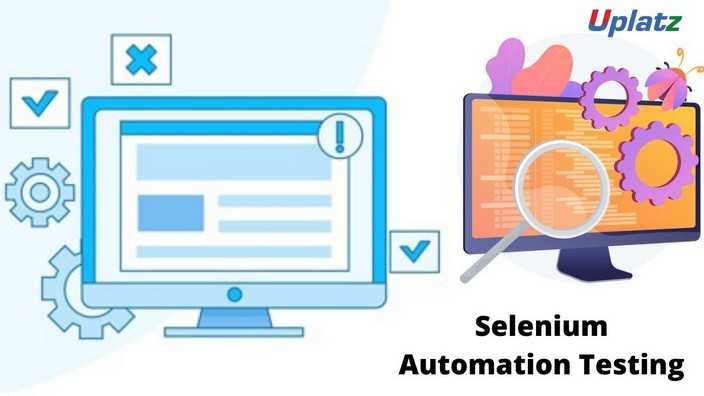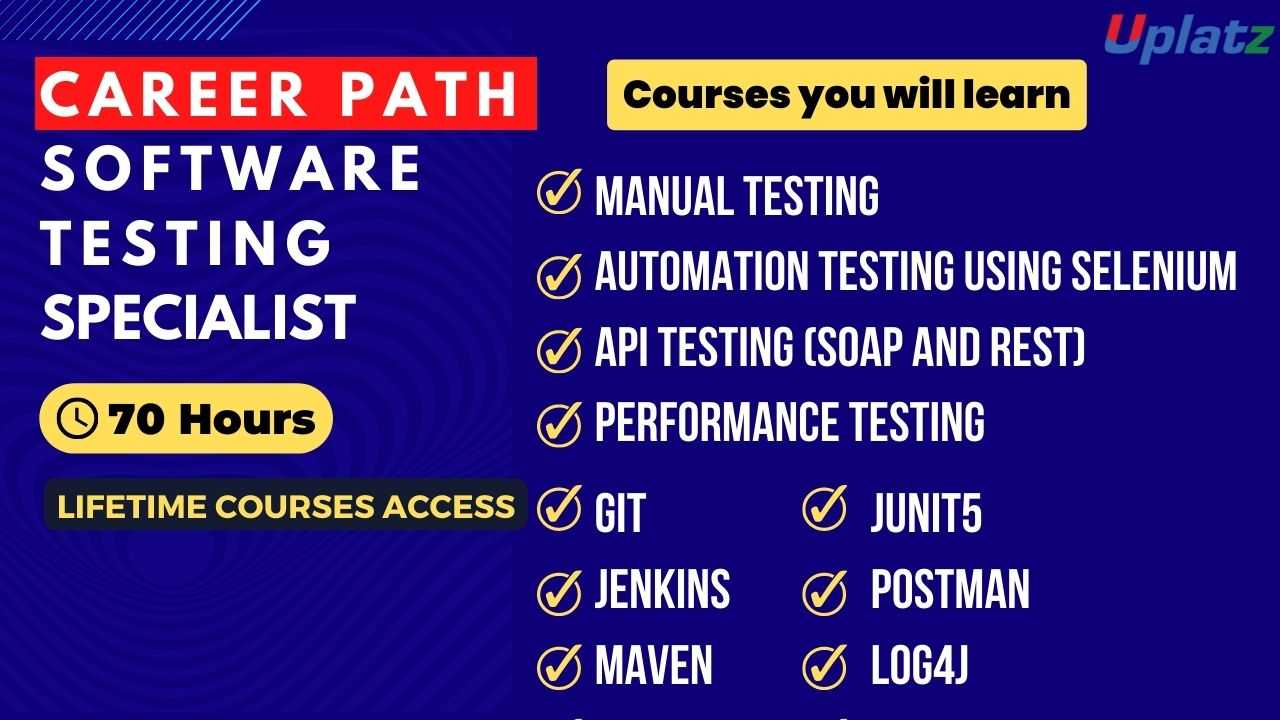Bundle Ultimate - Software Testing (Manual - Automation - API)
Get to know details aboutb Software Testing in Manual, Automation & API.Preview Bundle Ultimate - Software Testing (Manual - Automation - API) course
Price Match Guarantee Full Lifetime Access Access on any Device Technical Support Secure Checkout Course Completion Certificate 95% Started a new career
BUY THIS COURSE (
95% Started a new career
BUY THIS COURSE (USD 31 USD 69 )-
 96% Got a pay increase and promotion
96% Got a pay increase and promotion
Students also bought -
-

- Software Testing (Automation Testing with Selenium)
- 30 Hours
- USD 17
- 2519 Learners
-

- Software Testing (Manual Testing)
- 30 Hours
- USD 17
- 1554 Learners
-

- Career Path - Software Testing Specialist
- 70 Hours
- USD 45
- 222 Learners

Courses included in Bundle Ultimate - Software Testing (Manual - Automation - API)
1.Software Testing Manual: Manual Testing, as the name suggests, is a type of software testing where testing is taking out manually without using any automation tools. Manual testing is one of the most initial testing techniques, which is why any application is manually tested before carrying out automation testing. Manual testing allows the testers to find bugs in the software system. Automation testing is a type of software testing wherein automated processes are used for testing. It is transfer out by running test scripts using a tool. Tools such as QTP, Selenium, Test complete etc. are available for automation testing. Every software company needs Quality Testers without whom no software can be released. This Manual Testing training course will take you through the process of Software Testing, which contains planning, scheduling, test scenarios, error analysis, and so on. It also contains topics like performance testing, regression testing, text execution, preventive measures, generating test reports, and test metrics.
2.Software Testing Automation: Selenium is a set of software tools that supports test automation. This is the age of activeness, the age where software activities are highly responsive and interactive. Processes are required to be automated so that actions can run on a loop without much human intervention, thus increasing efficiency and lowering the chances of mistakes. An open-source, portable software testing framework for web applications, Selenium can be installed on a variety of platforms and supports a number of browsers such as IE, Firefox, Mozilla and others. By continuously offering itself to the frequent code changes that are a norm for the projects, Selenium is the perfect test automation tool that helps provide flawless products to satisfied customers.
3.API: PIs have become the center of software development, connecting and transferring data and logic across disparate systems and applications. Luckily, testing them can greatly improve the efficiency of your testing strategy as a whole, helping you deliver software faster than ever. API (Application Programming Interface) is a computing interface which enables communication and data exchange between two separate software systems. Software system that executes an API includes several functions/subroutines that another software system can perform. API defines requests that can be made, how to make requests, data formats that can be used, etc. between two software systems.
Course/Topic - Course access through Google Drive
-
Google Drive
-
Google Drive
a).Learn software Testing Manual
b).Learn selenium is a set of software tools that supports test automation.
c).Learn how to connecting and transferring data and logic across disparate systems and applications.
This comprehensive course covers the essential aspects of software testing, including manual testing, automated testing, and API testing. Participants will gain hands-on experience with various testing tools and methodologies, preparing them for real-world applications in quality assurance.
Part 1: Introduction to Software Testing
Week 1: Fundamentals of Software Testing
a).Overview of software testing: Objectives and importance
b).Types of testing: Manual vs. automated vs. API testing
c).Software development life cycle (SDLC) and testing life cycle (STLC)
d).Hands-on Exercise: Setting up a testing environment
Part 2: Manual Testing
Week 2: Manual Testing Techniques
a).Understanding requirements and test case design
b).Writing effective test cases and test plans
c).Test execution and defect reporting
d).Hands-on Exercise: Creating and executing manual test cases
Week 3: Testing Methodologies
a).Black-box vs. white-box testing
b).Functional vs. non-functional testing
c).Exploratory testing and usability testing
d).Group Activity: Conducting exploratory testing sessions
Part 3: Automation Testing
Week 4: Introduction to Automation Testing
a).Overview of automation testing: Benefits and challenges
b).Selecting the right tools for automation (e.g., Selenium, TestNG)
c).Understanding frameworks: Keyword-driven, data-driven, and behavior-driven development (BDD)
d).Hands-on Exercise: Setting up an automation testing environment
Week 5: Automation Scripting with Selenium
a).Introduction to Selenium WebDriver
b).Writing and executing test scripts using Selenium
c).Implementing waits, assertions, and reporting
d).Hands-on Exercise: Creating automated test scripts for a web application
Week 6: Advanced Automation Techniques
a).Integrating automation tests with CI/CD pipelines (e.g., Jenkins)
b).Understanding test maintenance and version control
c).Best practices for automated testing
d).Group Project: Developing a small automation framework
Part 4: API Testing
Week 7: Introduction to API Testing
a).Understanding APIs: REST vs. SOAP
b).Importance of API testing in the software development process
c).Overview of popular API testing tools (e.g., Postman, SoapUI)
d).Hands-on Exercise: Exploring APIs using Postman
Week 8: API Testing Techniques
a).Writing and executing API test cases
b).Validating responses and handling authentication
c).Performance testing of APIs
d).Hands-on Exercise: Creating automated API tests with Postman and Newman
Part 5: Advanced Topics in Testing
Week 9: Performance and Security Testing
a).Introduction to performance testing concepts (load, stress, and scalability)
b).Tools for performance testing (e.g., JMeter, LoadRunner)
c).Overview of security testing methodologies and tools
d).Group Activity: Designing a performance testing plan
Week 10: Best Practices and Future Trends in Testing
a).Best practices for software testing and quality assurance
b).Continuous testing and DevOps integration
c).Emerging trends: AI in testing, test automation, and shift-left testing
d).Group Discussion: Sharing insights on future testing trends
Part 6: Capstone Project
Week 11: Capstone Project Preparation
a).Overview of capstone project objectives
b).Defining project scope: Manual, automation, and API testing
c).Initial project planning and outlining tasks
d).Group Discussion: Feedback on project ideas
Week 12: Capstone Project Execution
a).Implementing the project using skills learned across testing methodologies
b).Presenting findings and solutions to the class
c).Peer reviews and discussions on project experiences
Recommended Resources:
a).Textbooks:
a."Foundations of Software Testing" by Dorothy Graham et al.
b."Automated Software Testing" by Elfriede Dustin et al.
c."API Testing and Development with Postman" by Dave Westerveld
b).Online Resources:
a.Udemy and Coursera for specialized courses
b.Software testing communities and forums for knowledge sharing
c).Tools:
a.Selenium, Postman, JMeter, and other testing tools for hands-on practice
Assessment:
a).Weekly quizzes and assignments
b).Mid-term project focused on manual and automation testing
c).Final capstone project showcasing a comprehensive testing strategy
This Software Testing (Manual and Automation) Training course is designed for exploring the structure, concepts of Software Testing (Manual and Automation)Manual testing. In manual testing, a human performs the tests step by step, without test scripts. In automated testing, tests are executed automatically via test automation frameworks, along with other tools and software.
Software Testing can be done using two methods or ways in various test levels. Software Testers vary from one test level to another, for example Developers perform Testing at the Unit Test level.The scope of automation is the area of your Application Under Test which will be automated. Following points help determine scope: The features that are important for the business. Scenarios which have a large amount of data.
Uplatz online training guarantees the participants to successfully go through the Software Testing (Manual and Automation) certification provided by Uplatz. Uplatz provides appropriate teaching and expertise training to equip the participants for implementing the learnt concepts in an organization.
Course Completion Certificate will be awarded by Uplatz upon successful completion of the Software Testing (Manual and Automation) online course.
The Software tester draws an average salary of $98,145 per year depending on the knowledge and hands-on experience. Software tester job roles are in high demand and make for a rewarding career.
These days there is a very good opportunity as well as growth in this career within the whole industry. I know most fresh graduates want to establish their career as Software Developer in industry but this is because they don't know more about other available opportunities within the industry.
As mentioned earlier, there are many roles and responsibilities of Automation Test Engineers. Some of the major roles and responsibilities of Automation Test Engineers include:
a).Identifying and selecting the automation test cases
b).Applying various designs and documenting the automation test strategy
c).Creating an automation test plan and getting approval
d).Configuring Selenium Test Environment (STE) in order to set it up
e).Participating in Selenium Environment Setup with an Integrated Development Environment (IDE)
f).Automating the design of a framework
g).Implementing it as per the structure of the project
h).Creating, enhancing, debugging, and running the test cases
i).Collating and monitoring the defect management process
j).Managing the changes and executing regression tests
k).Coming up with exact solutions for problems related to object identity and error handling
l).Interacting with customers/clients to solve the various issues they face and updating on the situation
Note that salaries are generally higher at large companies rather than small ones. Your salary will also differ based on the market you work in.
The following are the job titles:
a).Test Engineer .
b).Quality Analyst.
c).Testing Analyst.
d).Automation Engineer.
e).Test Architect.
f).Test Automation Developer.
g).Test Manager.
h).Director of Test.
Q1. What is Software Testing?
Ans-Software testing is the act of operating a system or application under control and then assessing their results. It is intentionally simulating a problem situation in order to work out a possible remedy in case a situation like that actually happens.
Q2. What kind of testing should we consider?
Ans-The basic testing to consider include Blackbox testing, Integration testing, Whitebox testing, User acceptance testing, Load testing, Acceptance testing, Performance testing, and Smoke testing.
Q3. What is Software ‘quality’?
Ans-Quality software is software that is reasonably free from bug, is up to the requirements and/or expectations, delivered on time and according to the budget, and is easy to maintain.
Q4. What is ‘Software Quality Assurance’?
Ans-Software Quality Assurance also known as Software QA, encompasses the entire process of developing software: observing and improving the process, seeing that the standards and procedures agreed upon are followed, and making sure that problems are discovered and also fixed.
Q5. Does every software project need testers?
Ans-This solely depends on the context or size of the project, the methodology of development, risks involved, and the experience and skills of the developers. Generally, every project would need testers, except in some cases. A project that is non-trivial sized or with non-trivial risks would need a testing staff. But whereby the project is for a short term, low risk, small, and with programmers that are highly experienced that are making use of test-first development or unit testing, such project may not need a test engineer for it to do well.
Q6. What is verification? And what is validation?
Ans-Verifications are reviews and meetings which are intended to help evaluate documents, code, specifications, and requirements. It is usually done with checklists, walkthroughs, issues lists, and inspection meetings.
Validation, on the other hand, entails the real testing and it is done after completing the verification.
Q7. What is Regression testing?
Ans-This is the act of retesting a program that has been tested previously in order to be sure that there has not been any fault following the modification or that no new fault has been introduced.
Q8. What is a ‘test plan’? What is a ‘test case’?
Ans-A software project test plan is a document that explains the objective, approach, focus, and scope of a software testing. A test case, on the other hand, is a document that explains an action, input, or event, and a response that is expected, to help decide if an application’s feature is functioning properly.
Q9. Why does software have bugs?
Ans-Software has bugs for the following reasons
1).Errors in programming
2).Lack of communication or no communications at all
3).Requirements changes
4).Time pressures
Q10. What should you do after finding a bug?
Ans-You need to report the bug and then assign it to developers that can take care of it. When you have fixed the problem, retest the fixes, decide the requirements for regression testing in order to be sure that no more problems are eventually caused by the fixes.
Q11.How can you introduce new Software QA processes to an existing Organization?
Ans-This is usually determined by the organization’s size as well as the risks involved. If it is a small project or group, it may be better to use a more ad-hoc process, depending on the customer and project type. It can also be done via incremental self-managed team approaches.
Q12.What are 5 common problems in the software development process?
Ans-
a).Schedule that is unworkable
b).Requirements changes
c).Inadequate communication
d).Insufficient testing
e).Poor requirements
Q13.What are the 5 common software development problems solutions?
Ans-
a).Schedule that is practicable
b).Clear communication among the project team members
c).Firm requirements
d).Clearness of requirements
e).Sufficient testing
Q14.What steps are needed in developing and running software test?
Ans-
a).Get the requirements, functional design, and plan for the internal design, and other documents that are relevant.
b).Get budget and the schedule conditions
c).Decide project framework
d).Recognize risks
e).Decide testing approaches, process, test setting, test data
f).Carry out test
g).Carry out reviews and evaluations
h).Sustain and keep documents up to date
Q15.What is the best software test estimation approach?
Ans-This is determined by the organization, the type of project, and the experience of the involved personnel. However, here are a few approaches to consider:
a).Metrics-Based Approach
b).Implicit Risk Approach
c).Percentage-of-Development Approach
d).Test Work Breakdown Approach
e).Iterative Approach
Q16.How does a client/server environment affect testing?
Ans-Client/server applications are sometimes complex as a result of the multiple dependencies among clients, communication of data, server, and hardware, particularly multi-tier systems. Stress/load/performance testing can help to determine the capabilities and limitations of client/server application.
Q17. What are the attributes of a good software QA engineer?
Ans-They should be able to comprehend the whole process of software development and how it blends with the organization’s goal and the business approach. Diplomacy and patience are highly required in the early phases of QA processes implementation. For inspections and reviews to be successful, ability to identify problems and spot ‘what is missing’ is a must.
Q18.What information does a test strategy capture?
Ans-It captures the general approach’s explanation to be used as well as the testing styles, specific types, and techniques.
Q19.How can we test World Wide Web sites?
Ans-Things to consider might include:
a).Testing the HTML specification, internal and external links
b).Testing the server’s expected loads
c).Testing the securities needed to be implemented and verified
d).The applets, ActiveX components, cgi programs, javascript, etc that you need to track, maintain, and control
e).Performance that you should anticipate on the side of the client.
Q20.What is extreme programming and what has it got to do with testing?
Ans-Extreme programming otherwise known as ‘XP’ is a software development step taken by small teams working on projects that are susceptible to risk and also have requirements that are not steady. To carry out extreme testing, it is expected that the programmers should first write unit and functional test codes before the application code is written. It is also important to make the customer an important part of the project team and assist in developing scenarios that would enable you to conduct acceptance/black box testing.
Q21.What is ‘good code’? What is ‘good design’?
Ans-‘Good code’ is a code that works well, has no bug, can be read, and can be maintained. Good internal design signifies a software code with a clear, understandable, modifiable, and maintainable overall structure. It has to be robust with the capacity for adequate error handling and status logging and works properly when it is executed. Good functional design refers to an application with a functionality that one can trace back to the requirements of the end-user and customers.
22. How can you know when to stop testing?
Ans-The following factors determine when to stop testing:
a).Deadlines such as testing deadlines, release deadlines, etc are met
b).Test cases are completed with ‘pass’ in certain percentage
c).Exhaustion of test budget
d).Coverage of code/requirements/functionality attains a specified point
e).A drop in the rate of bug below a certain level
f).An end of the beta or alpha testing phase
Q23. What if there is not enough time for detailed testing?
Ans-
a).Decide where to focus the testing with the help of risk analysis
b).Decide which important functionality is to be tested
c).Establish the aspects of the project that are high-risk
d).The kinds of test to be performed have to be prioritized
e).The tests to have the best high-risk-coverage to time-required ratio have to be decided.
Q24.What is the main objective when reviewing a software deliverable?
Ans-To discover fault in any software work product
Q25. What determines the level of risk?
Ans-The level of risk is determined by the likelihood of an adverse event and the impact of the event
Q26.What is the benefit of test independence?
Ans-It prevents the partiality of the author in defining effective tests.
Q27. What is SEI? CMM? CMMI? ISO? Will it help?
Ans-They are all standards that decide effectiveness in quality software delivery. They help organizations in identifying best practices that are valuable in assisting them in increasing the maturity of their processes.
Q28.What is integration testing?
Ans-This is the testing carried out to be sure of the accurate operation of the components in the implementation model when combined to execute a use case.
Q29.What is developer testing?
Ans-Developer testing refers to the aspect of test design and implementation that the team of developers considers most appropriate to undertake.
Q30. What is system testing?
Ans-It is the series of tests aimed at making sure that the modified program is able to interact properly with other components of the system.









